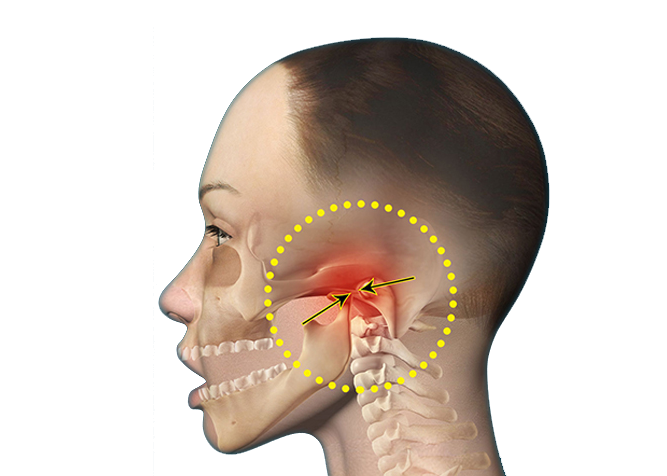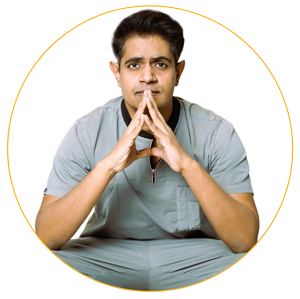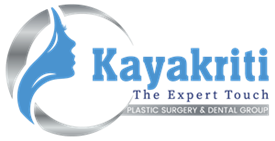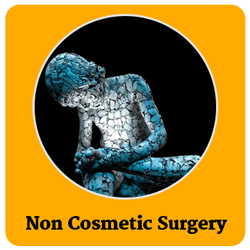TMJ Ankylosis
When lower jaw fuses with the skull bone at its joint, it is called Temporomandibular joint ankylosis.

When lower jaw fuses with the skull bone at its joint (condyle of the mandible fuses with glenoid fossa of the temporal bone), it is called Temporomandibular joint ankylosis. It leads to obliteration of normal articulation and finally immobile jaw (mandible).
Normally during all the movements of the jaw, only the lower jaw moves. This movement is possible at the Temporo- mandibular joint (TMJ). TMJ is located on both sides of face, just in front of the ears and connects our lower jaw (the mandible) to the skull bone (temporal bone). TM Joint- slides as well as rotates and assist in movements like chewing and speaking.
Temporo-mandibular joint (TMJ) is unique as joint on both the sides of face functions as one unit. Since TMJ is connected to the mandible, the right and left joints must function together and therefore are not independent of each other. It has gliding function (side to side) and hinging (front and back) function.
Normal full jaw opening is around 4-5 cm as measured from the edge of lower front teeth to edge of upper front teeth. The movements occur mainly by the four muscles : the masseter, medial pterygoid, lateral pterygoid and the temporalis. These four muscles move the mandible in different directions.
Causes of TMJ Ankylosis
- TMJ ankylosis may be due to any trauma over TMJ region like
- condyle fracture
- collection of blood
- injury during childbirth
- TMJ ankylosis may be due to any inflammatory condition (like arthritis)
- TMJ ankylosis may be due to any infection of ear ordue to post operative complication of TMJ surgery.
It may be one sided or both sided, with different types of appearance on face.
Symptoms of TMJ Ankylosis
It is very commonly seen in children.
Usually, they come with zero mouth opening and deformity of the lower jaw. Ankylosis leads to arrest of condylar growth so facial asymmetry is common in children Most of the times,patients or parentsof the affected children would have consulted many physicians but the correct diagnosis would not have been reached.
The classical symptoms of TMJ ankylosis are
- Painless limitation of jaw motion.
- Decreased mouth opening
- varying degree of lower jaw deformity
- nutritional deficiencies
- malalignment of teeth
- halitosis and caries in teeth
Diagnosis of TMJ Ankylosis
Diagnosis of TMJ ankylosis is mostly clinical but it is supplemented with few investigations like
- Orthopantomogram of mandible (OPG Xray)- This Xray will show the bony fusion between both the bones
- 3D CT Scan of face- is the gold standard investigation for TMJ Ankylosis. It not only shows the Bony fusion but also the extent of the Bony block and the jaw deformity
Intra-articular (true) ankylosis must be distinguished from extra-articular (false) ankylosis, which may be caused by enlargement of the coronoid process, depressed fracture of the zygomatic arch, or scarring resulting from surgery, irradiation, or infection. In most cases of true ankylosis, x-rays of the joint show loss of normal bony architecture.
Treatment of TMJ Ankylosis
TMJ Ankylosis is completely treatable with surgery. Restoration of mouth opening is the primary aim of treatment. The lower jaw (mandibular deformity) is corrected later during second stage surgery.
Restoration of mouth opening-The patient is admitted one day before surgery and all pre-operative investigations are done. Anesthetising the patient with TMJ ankylosis is very challenging as mouth opening is nil and nasal intubation must be done. We have a very competent intensivist and anaesthetistin our team who has managed innumerable number of such casestill now.
During surgery, incision is given in front of the ear within its folds so that the incision is very well hidden and not visible to human eye. The Bony block is removed and space is created between the mandible below and the temporal bone above to achieve anormal mouth opening of 4 cm.
This gap between the bones is usually filled bya facial flap harvested from the scalp region so that the ankylosis does not recur. If TMJ Ankylosis is present on both the sides, then same procedure is repeated on the other side.
Incision is closed over a drain which is removed on post operative day 2. Patient isdischarged from the hospital after drains are removed. Sutures are removed on 7th day after the surgery.
Regular Jaw-opening exercises must be done for 6 months minimum to maintain the surgical correction but forced opening of the jaws without surgery is not indicated and is usually ineffective because of bony fusion.
There are chances of temporary paresis or paralysis of facial nerve or one of its branches during the surgery leading to paralysis of one side of the face which happens in 5 to 10% of cases. The recovery takes around 3 to 6 months and is usually complete. Permanent damage to facial nerve occurs in only 1% to 2% of the cases with abnormal anatomy, more widespread diseased segment.
Correction of mandibular deformity can be done with orthognathic surgery procedures notably Bilateral Saggital Split Osteotomy (BSSO) and genioplasty or chin surgery. These patients also require orthodontic treatment for correction of the alignment of their teeth.
Orthognathic surgery is usually done as a second stage procedure when the children have completed their skeletal maturity i.e., 14 to 16 years for girls and 16 to 18 years for boys.
Bilateral Saggital Split Osteotomy (BSSO)should be done when the whole lower jaw is underdeveloped and retruded and requires advancement or to be brought forward.
Genioplasty or chin surgery is a single cosmetic procedure which gives the maximum aesthetic correction in boys and girls with receding chin and less deformity of the whole lower jaw.
Know your surgeon better

Best plastic surgeon, Dr. Amit Agarwal is an American Board Certified, extensively trained, and best Plastic & Aesthetic surgeon in Lucknow. He is the Chief Plastic Surgeon heading the Department of Plastic, Microvascular, and Craniofacial surgery at Vivekananda Polyclinic and Institute of Medical Sciences, Lucknow, U.P, India. He maintains a busy practice at Avadh and Nishat Hospital and his own center - Kayakriti Plastic Surgery & Dental Center. He was formerly a Consultant in the Department of Plastic Surgery and Burns at the prestigious SGPGI, Lucknow.
MS, DNB (General Surgery) MCh, DNB (Plastic Surgery),
MNAMS, FACS, FICS, FRCS (Edinburgh, UK)
His Credentials
Three pillars of kayakriti
Privacy
We believe your experience with us should be comfortable and hassle-free to make it one of your best lifetime experiences for yours. We, here at the clinic, take full precautions to maintain your privacy in any manner. We also provide a staff who will receive you from the gate and take you to the chamber directly if you demand.
Trust
Our Surgeon is highly qualified and internationally certified with a team of skilled staff to perform any surgical or non-surgical treatment on your body.
Safety
When you plan to undergo any surgery you should always keep in mind that it's your body and it's a surgery. We, here always keep your safety a priority and will never recommend you to undergo any such procedure which is not safe for you. We also provide you with a detailed description of the complications which may occur after the surgery during the consultation as it's a surgical procedure so there may be some complications depending on the way your body reacts.
Kayakriti in news



Frequently Asked Questions
If you have flat or small breast and you want to improve your breast and hip contour ratio then you are a good candidate for it. The answer will be best provided after the first consultation with Dr Amit Agarwal.
Acute pain will be there for almost a week which gradually reduces and there will be soreness and swelling which may take up to 3 weeks to subside.
You can join your work and daily routines after a week of the procedure and can start exercising after 3 weeks of it.
Yes, you have to wear it round the clock unless we suggest you to remove it.
This surgery does not affect the ducts or the areas of the breast involved in milk production. Thus, it does not affect the breast feeding.
This surgery does not affect the ducts or the areas of the breast involved in milk production. Thus, it does not affect the breast feeding.












Kayakriti Plastic Surgery & Dental Center
D-43, Near Punjab National Bank, Rajajipuram, Lucknow, Uttar Pradesh - 226017, India
Phone No. +919695940009, +919695940006
Map Location





























Social Media Presence